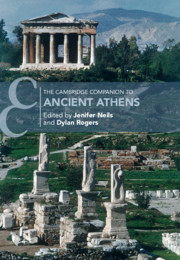Book contents
- The Cambridge Companion to Ancient Athens
- Cambridge Companions to the Ancient World
- The Cambridge Companion to Ancient Athens
- Copyright page
- Contents
- Contributors
- Abbreviations
- Athens: An Introduction
- 1 #Leagros: An Athenian Life
- Part I The Urban Fabric
- Part II Inhabitants
- 11 Population and Social Structure
- 12 The Athenian Family
- 13 Death and Disease
- 14 Animals in Athenian Life
- Part III Business/Commerce
- Part IV Culture and Sport
- Part V Politics
- Reception
- Index
- References
13 - Death and Disease
from Part II - Inhabitants
Published online by Cambridge University Press: 10 March 2021
- The Cambridge Companion to Ancient Athens
- Cambridge Companions to the Ancient World
- The Cambridge Companion to Ancient Athens
- Copyright page
- Contents
- Contributors
- Abbreviations
- Athens: An Introduction
- 1 #Leagros: An Athenian Life
- Part I The Urban Fabric
- Part II Inhabitants
- 11 Population and Social Structure
- 12 The Athenian Family
- 13 Death and Disease
- 14 Animals in Athenian Life
- Part III Business/Commerce
- Part IV Culture and Sport
- Part V Politics
- Reception
- Index
- References
Summary
The history of Athens was influenced by the health of her citizens; from birth to old age, disease, injury, and warfare threatened the lives of citizens, or made them unable to participate in the life of the city. The study of skeletal remains from burials in Athens reveals the effect of these threats, and offers new information on historical plagues, attacks on the city, and ordinary events in the lives of Athenians.
- Type
- Chapter
- Information
- The Cambridge Companion to Ancient Athens , pp. 188 - 198Publisher: Cambridge University PressPrint publication year: 2021
References
Further Reading
A recent exhibition at the Museum of Cycladic Art on ancient health practices and cults has summary essays on various aspects of health and disease (Stampolidis and Tassoulas 2014). Two collections of papers on ancient health provide a wide range of perspectives on the topic (Hope and Marshall 2000; King 2005). The Phaleron Archaeological Project being conducted at the Malcolm Weiner Laboratory for Archaeological Science of the American School of Classical Studies at Athens has, as of this writing, begun to move from cleaning and preparation to publication of 1,200 skeletons. This enormous cemetery of the early port of Athens will provide an unparalleled view of the lives of ordinary Athenians, slaves, and convicted criminals. Updates are available on the project website: http://phaleron.digital-ascsa.org/.
Bibliography
Additional resources to accompany this chapter can be found at: www.cambridge.org/NeilsRogers

